|
|
Velocipede

|
|
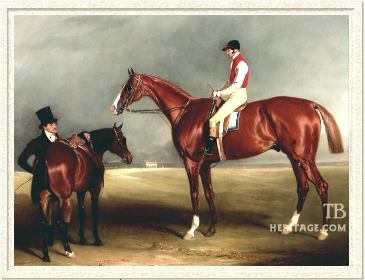 |
|
|
Velocipede was a solid north country runner who won two cups and several other good races, despite a leg injury which often troubled him and eventually led to his retirement from the turf. He was the sire of three classic winners in England, and a great many other solid performers, but none of his sons were able to forward this branch of the sire line. Some of his daughters won good racers, especially his dual-classic winning filly, Queen of Trumps, and a number of them became dams or grandams of successful 19th century racehorses and sires.
|
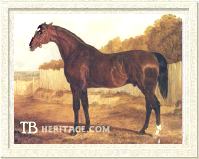
Blacklock
| |
His sire, Blacklock, was a great stayer with a huge stride. He had a deep shoulder and girth, and a muscular neck, vertical pasterns, and an unattractive head with a Roman nose, all traits which he passed on to many of his offspring. His sire, Whitelock, was a fair stayer and winner of four and two mile heats, but had an indifferent race record and was used as a country stallion after he was retired from the turf. Blacklock's dam, a mare by Coriander, had been purchased for £3 by Francis Moss at the York horse market, and her foal, Blacklock, was sold to a Yorkshire horse dealer, Thomas Kirby, for £40 when a yearling, who sold him at age two to Richard Watt of Bishop Burton, near Beverley, Yorkshire. Blacklock's dam later produced the St. Leger winner Theodore (1819).
|
Blacklock ran until the age of five, winning the York Cup, the four-mile Great Subscription Purse at York twice, and some other races in the north, and was retired to stud in Watt's ownership, standing at various public stables at at Bishop Burton throughout his stud career, dying fairly early at the age of 17. He was a successful stallion, siring over seventy winners of 442 races, and was leading sire in England in 1829. His son, Voltaire, continued the sire line through to St. Simon, and Lollypop, his daughter, produced Sweetmeat, a key sire in the Byerley Turk sire line.
The blaze-faced Velocipede was born in 1825, near York, bred by horse dealer Francis Moss, who had also bred his sire. His dam, an 1817 mare by Juniper, out of a Sorcerer daughter, was barely 15 hands tall; she produced sixteen foals between 1821 and 1841 (Merope, by Voltaire, being her last), over half of them by Blacklock, and most of them were winners on north country courses. A brother to Velocipede, Malek, was a distance horse who placed in some good races, including the Newcastle Gold Cup and the Caledonian Hunt's four-mile King's Guineas. A sister to Velocipede, Moss Rose, won the Liverpool St. Leger, and ran second to Walton in the Stand Cup at Chester in 1831; she later produced Nassau Stakes winner Rosa Bianca (1837, by Augustus). Other daughters out of Velocipede's dam were also excellent producers; one, Estelle (1836, by Blacklock's son, Brutandorf) the dam of 1,000 Guineas winner Pic-Nic (1842, by Glaucus), who in turn produced a classic-winning daughter in Mayonaise, who established a successful female line. The Juniper mare's last filly, the bay Merope (by Voltaire), was the second dam of Derby winner Galopin and 2,000 Guineas winner Moslem, and also established a strong female family.
While he had his sire's Roman nose, deep girth, and well-muscled neck, Velocipede was, unlike most Blacklock progeny, light-boned, and as a yearling was weedy and tall--he eventually reached 16 hands in height. He was seen by the jockey-trainer, William Scott, as a yearling, who purchased him for William Armitage for £120, and was sent to the Scotts' Whitewall stable near Malton for training. Scott had first brought Velocipede to the attention of Thomas Houldsworth of Rockwood, who owned the 1816 St. Leger winner Filho-da-Puta, and for whom the Scott brothers, William and John ("The Wizard of the North") trained and rode until 1825, when they established their own stable. Upon seeing Velocipede, Houldsworth declared he "would not give sixpence for such a slight-legged one." At some point during his racing or training, he developed a "knot" on a foreleg, which periodically aggravated a tendon, earning him the sobriquet "the magnificent cripple."
Velocipede on the Turf
Velocipede was sent out four times at the age of two, and won three, placing second once. His wins were a 20 sovereign sweep at Catterick, where he beat five other two year olds (Gameboy by Octavian was second); a £360 race at York spring meeting, with other juveniles, including the Tramp filly, Ballad-Singer, who would later win at York; and a £380 race at Northallerton, where he beat six other colts and fillies, with Gameboy running second again. His second place finish was to the great race filly Bessy Bedlam in a sweepstakes for juveniles at Doncaster.
At age three, 1828, he started the season by winning the St. Leger Stakes at York spring meeting, beating the rest of the field by 100 yards. He ran third in the Doncaster St. Leger to The Colonel and Blacklock's daughter, Belinda, having been overtaken by both of them towards the end of the race and unable to hang on to his lead. He had, by this time, developed the knot on his leg, and it was later noted The Colonel would never have won the St. Leger had Velocipede "been sound and well."
In his last season, 1829, he began by winning the two mile York Gold Cup at the spring meeting, beating Blacklock's son Laurel, the Catton colt Nonplus, and Actaeon, all high class runners; this race excited some large wagers, almost exclusively on whether Laurel or Velocipede would win. Laurel's jockey sent him to the front immediately, gauging that his distance horse (Laurel would win two Cups in 1829) could keep the others at bay if he took the lead. At the stands Velocipede's jockey, George Nelson, asked and received a tremendous burst of speed from Velocipede, who won by half a length.
Velocipede won his two other races that season, as well: a 200 sovereign match over the Two Year-old Course at Doncaster against Bessy Bedlam, which he won by several lengths, and the Liverpool Cup over two miles, beating Laurel, Dr. Faustus, Chester Cup winner Halston, the good cup winner Pelion (by Blacklock), and Economist. He was saddled for the Stand Stakes at Chester, but was so lame, he was withdrawn from the race, and was not seen on the turf again.
Velocipede in the Stud
Velocipede was retired to Armitage's stud at Ainderby Hall in Northallerton, Yorkshire; a local ale house hung is portrait on its sign there. He was later sold to a Cumberland squire, Mr. Hobson, who first stood him at stud at Shadwell Lane Paddocks, near Leeds, and then at Coney Hall, Cumberland. He sired three classic winners: Queen of Trumps (1832, out of Princess Royal by Castrel), who won the Oaks and the St. Leger; Amato (1835, out of Jane Shore by Woful), winner of the Derby and nothing else; and Meteor (1839, out of Dido by Whisker), who won the 2,000 Guineas. His best were Queen of Trumps, Hornsea, and Joe Lovell, the latter two good north country runners.
|
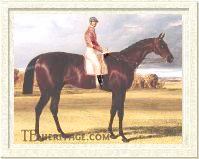
Amato
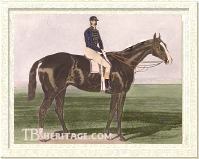
Meteor
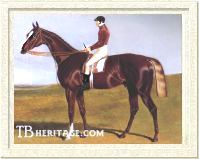
Hornsea
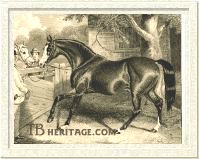
Joe Lovell
| |
His two classic winning sons, AMATO (1835, out of Jane Shore by Woful) and METEOR (1839, out of Dido by Whisker), did not do much other than win their respective classic races, the Derby -- Amato's sole race -- and the 2,000 Guineas. Amato died early, in 1841.
A better runner was HORNSEA, bred in 1832 by W. Richardson out of a Cerebus mare, a north country distance horse who looked a great deal like his sire. Sold to George Stanhope, the Earl of Chesterfield, at age three he ran second to the Queen of Trumps in the Doncaster St. Leger, and won the Newcastle St. Leger, a King's Plate worth 100 guineas at York, and the Heaton Park St. Leger. In 1836 he won the Surrey and Middlesex stakes over two miles at Egham; a King's Plate at Egham over two miles, beating Pussy; the Goodwood Cup, beating nine horses; the Newmarket Cup, beating Aurelius; a King's Plate at Newmarket, beating Rioter and Mozart. Hornsea's contribution to the breed was siring a moderately good racing filly, Little Fairy, who became the third dam of the influential late 19th century stallion, St. Simon.
Another good running son -- against second tier company -- was the blaze-faced bay JOE LOVELL (1841), out of the Partisan's Oaks-winning daughter, Cyprian. He ran third and last in his only race at age two, the Municipal Stakes for two year olds at Doncaster, won by a unnamed Velocipede colt. At age three he won the Great Yorkshire Stakes at York, and the Three Year Old Stakes at Doncaster, ran second in Goodwood's Drawing Room Stakes, third in the 2,000 Guineas to The Ugly Buck, and went unplaced in Goodwood's Racing Stakes. He started once at age four, winning a sweepstakes for 300 sovereigns at Goodwood.
Other Velocipede sons included MILLEPEDE (1838), who won the Ebor Stakes at York and the Chester Cup (beating Alice Hawthorn); KNIGHT OF THE WHISTLE (1838), winner of the Chesterfield Cup and the Middlesex and Surrey Stakes at Hampton; LYONS (1843), winner of the Coffee Room Stakes at Newmarket; BLANKNEY (1834), winner of the Brighton Gold Cup; WINESOUR (1840), Tyro Stakes winner at age two, and second in the Cesarewitch and the Newcastle Cup; THE SKATER, who ran second in the Ascot Stakes at age six; Confederate, second to Crucifix in the 2,000 Guineas; AINDERBY (1832) won the York Derby (later purchased by Lucius Polk of Mount Pleasant, Tennessee, arriving in the U.S. in 1838 where he sired 25 winners of 37 races between 1843 and 1854); ANTIDOTE (1840), winner at age three at Newmarket; CAPOTE, a youngster who ran in top company as a juvenile, placing third in Hopeful Stakes, third in the Clearwell Stakes, and third in the Prendergast Stakes, all at Newmarket. Other Velocipede sons, such as Prince Royal, and several unnamed youngsters, also won and placed in north country venues.
|
Velocipede's best youngster on the turf -- and one of the best mares to run in England -- was QUEEN OF TRUMPS (1832), whose dam, Princess Royal, had been a very good race filly. Queen of Trumps was the first to her time to win both the Oaks and the St. Leger.
Running for her owner-breeder Edward Lloyd Mostyn, as a juvenile she won the Champagne Stakes at Holywell Hunt meet, her only race that year. At age three, she won the Oaks (not having started in the 1,000 Guineas), beating a very good field of fillies easily. She won the Dinner Stakes at Liverpool in a canter, beating three horses, and then won Doncaster's St. Leger, beating Hornsea, Sheet Anchor, the 1,000 Guineas winner Preserve, Mundig, and others, winning easily when let go. Her other wins that year were the Stand Cup at Chester, the Newton Cup, and a 200 sovereigns at Holywell Hunt in a race she won by ten lengths; she also had a walk over for the Chieftain Stakes at Holywell Hunt, and a walk-over at Holywell Hunt for 180 sovereigns. Her only loss was the Scarborough Stakes at Doncaster, where she was thrown offstride by a wayward bulldog. Through her daughters she became tail-female ancestress of a number of stakes winners (Family 2 - m). |
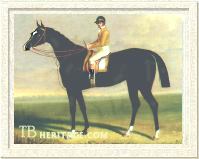
Queen of Trumps
| | Another Velocipede daughter who did well on the turf was CAROLINA (1836, from Nanette by Partisan), who ran second to Deception in the 1839 Oaks; she did not produce anything in the stud. Another filly by Velocipede, MICKLETON MAID (1836, out of Whisker daughter Maid of Lune (Family 7 - c)), did not place in the Oaks, but did win Doncaster's Park Hill Stakes that year, and ran third in the Cambridgeshire to Hetman Platoff and Lanercost, and in 1840 won the Warwick Gold Cup. A number of good stakes winnners descend from Mickleton Maid, primarily through her daughter Wiasma (1845), who was the dam of Ascot Stakes winner Mouravieff (1856), Criterion Stakes winner Klarikoff (1858), and the filly Klarinska (1862), who won the Great Yorkshire Stakes and the Yorkshire Oaks.
|
Another Velocipede daughter, Major Nicholas Yarburgh's OMNIBUS (1831, from Laurel's dam, Wagtail), never won anything, but did run third to Bran in a sweepstakes for three year olds at York; she later became dam of John Bull (1841), who won the Union-Rennen in Germany.
MADAME PELERINE (from Baleine by Whalebone, bred by Richard Watt) was Velocipede's only daughter to produce a classic winner, in the excellent race filly by Melbourne, Canezou (1845), who won the 1,000 Guineas, and also took the Doncaster Cup twice, as well as the Nassau Stakes and the Park Hill Stakes. Canezou, in turn, became the dam of 2,000 Guineas winner Fazzoletto (1853), of Paletot (1852), who won the St. James' Palace Stakes, of the good north country runner Cape Flyaway (1857), and through a daughter she was grandam of the excellent French racehorse and sire Boiard (1870), who won the Grand Prix du Jockey Club (French Derby), Grand Prix de Paris, the Ascot Gold Cup, and other top races.
Other good producing Velocipede daughters included ROCBANA (1831) and HER MAJESTY(1832), from the Walton daughter, Miss Garforth; Dido, Meteor's dam, was also a daughter of Miss Garforth, all of them bred by Armitage at Ainderby. Rocbana was the dam of Paragone, who sired the important mare Paradigm (Family 1 - j, dam also of English triple crown winner Lord Lyon), and also sire of classic-winning fillies in Germany; Her Majesty's daughter, Princess Alice (1843, by Bay Middleton) won Doncaster's Champagne Stakes and the Nassau Stakes.
Other Velocipede daughters included: VERBENA (1832, from Rosalba by Milo), dam of Uriel (1846), winner of the St. James' Palace Stakes, of Umbriel (1850), who won the Great Yorkshire Stakes, and Ithuriel (1841, by Touchstone), a stallion important in the Camel sire line; VALENTINIA (1845), dam of Clothilde (1852), winner of the Park Hill Stakes and the Stewards' Cup; FLORENCE (1839), dam of The Italian (1847, by Touchstone), who won the Champagne Stakes; VANISH (1843), dam of another Park HIll Stakes winner, the in-bred Hepatica (1855, by Voltigeur); FLASH OF LIGHTNING (1843), whose son, Jasper (1864, by King Tom) won the Royal Hunt Cup, and who was, through a daughter, second dam of Jockey Club Cup winner Carnelion (1872).
Other Velocipede daughters also bred on, notably, LADY SARAH (1841), whose grandson Ely (1861) won the Ascot Gold Cup, Goodwood Cup and other races, and whose daughter Georgine won in Hungary; FLIGHT (1831, from Miss Wilkes, by Octavian), who produced an inbred unnamed daughter by Laurel, dam of two Oaks winners; Blue Devils (1837, from Care, by Woful), dam of the Goodwood Cup winner and later good sire Saunterer (1854); DIGGERY DIDDLE (1841), the second dam of two French classic winners, Tyrolienne (1872, French Oaks), and Sire (1870, French 2,000 Guineas).
--Patricia Erigero
|
|
|
|

